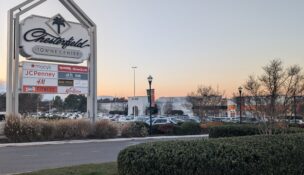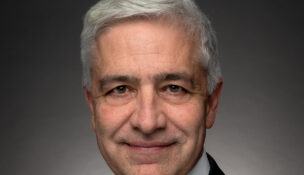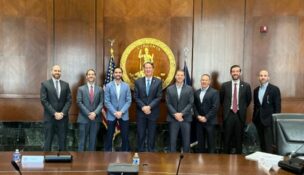Economist predicts last-minute deal on debt ceiling
Millennials raising families in the suburbs? Political standoffs becoming the new normal? Topics ranging from demographics to politics and economics were discussed Tuesday at Virginia Commonwealth University’s 23rd annual Real Estate Trends Conference in Richmond.
About 1,200 people gathered at the Greater Richmond Convention Center for the conference. It got off on a positive note with VCU President Michael Rao announcing a major gift, $1 million, from Richmond businessman Sam Kornblau to advance VCU’s real estate program.
Kornblau, chairman of SAMCO Development Corp. in Henrico County and a member of the board of directors of Eagle Construction, has been in the real estate industry more than 60 years. In 2006, he gave a $2.5 million gift to establish a real estate institute in the School of Business.
The newly named Kornblau Real Estate Program focuses on research related to commercial and residential real estate.
The conference’s keynote speaker, Marci Rossell, former CNBC chief economist and co-host of “Squawk Box,” said this year’s continuing economic recovery hinges on three factors: real estate, the political situation and the behavior of the stock market.
In terms of booms and busts, she said, the housing market generally follows a 10-year cycle. “If it peaked in 2006, … we shouldn’t expect anything close to normal activity until 2016,” she said.
The good news is that activity in the housing market and housing prices have been tracking up, which has a positive effect on what she called the “wealth effect.”
“If you bought a house in 2009, -10, or -11, in one of those years, how are you feeling? Like a genius, right? You have an asset that’s appreciated by 10 percent the first year and another 10 percent in the second year. For every dollar that your housing wealth goes up, that translates into your spending going up by 5 to 8 cents.”
Put another way: People feel wealthy and are more likely to spend when home values are going up and unemployment is going down.
Rossell didn’t shy away from commenting on the political situation, a topic on everyone’s mind with Congress and the President locked in a standoff over funding that has resulted in a partial shutdown of the federal government and threatens to carry over to a fight over raising the debt ceiling by Oct. 17.
Her analysis surprised some people: “ The political situation, believe it or not, is better this year than last,” she said. “Last year, we were all worried we were going to go over the ‘fiscal cliff.’ Sequestration went into effect, and we didn’t go over the fiscal cliff; we went over a fiscal bunny slope.”
What makes this year different, she added, is that instead of being terrified, “we’ve come to accept that this is the reality of democracy today in the modern world.” While the politics are ugly, a democracy is better than a dictatorship, she said.
Rossell also takes comfort from the financial markets. She says they are not behaving as if a crisis is imminent. “ The stock market has been going up pretty consistently the last three years … If we were going to see a default, the markets would be going crazy right now, and they’re just not. This is what they're saying: they are going to cut an 11th-hour deal; it will be temporary. We will lurch from temporary deal to temporary deal, because no one wants to give. We’ve become entrenched. There’s no middle ground any longer. This is the reality of it. “
A brighter picture of the future, particularly for Richmond, came from speaker Joel Kotkin. He’s a presidential fellow in urban futures at Chapman University in Orange, Calif., and author of “The next hundred million: American in 2050.”
Kotkin described Richmond as an aspirational city, growing in population and located in one of the top-ranked states for business — the kind of second-tier city that attracts people. “You are drawing heavily from the Northeast corridor, from Boston, New York and Washington, D.C. People from those places are coming here. You’re also beginning to get some migration from Southern California and from Louisiana and parts of Florida.”
Housing affordability is a critical factor in these moves and will become more critical as the Millennials, people now 12 to 30, get older, marry and have families. While young professionals might be flocking to cities now, Kotkin says his data show that “ Millennials like the suburbs more than their parents. Most of them grew up in the suburbs. They will also look at close-in urban neighborhoods,” with housing prices, crime and quality of schools affecting where this group will live, Kotkin said.
Of course today’s suburbs are starting to look different, he added, with walkable, mixed-use town centers, plenty of parks and a more diverse population, including boomers who want to age in place.
In a recent survey of where people wanted to live, Kotkin said a majority of respondents, 28 percent, preferred a suburban area with a mix of housing and businesses. Most people also want to live in a single-family home, he said, even though the multifamily sector has seen a surge of growth in recent years as home ownership dropped in response to the recession.
Looking to the future, Kotkin said the three key demographic groups would be immigrants, the Millennials and aging baby boomers. By 2050, the makeup of the American population will change dramatically, he added, with barely 50 percent identifying themselves as white, non Hispanic, compared with 65 percent now.
A downtown like Richmond will require that people come in to attend activities, Kotkin said. “Central cities can do certain things that suburbs cannot.”
With its population growing, “Richmond has had one of the most drastic changes of any place in the country. You’re going through a massive change. This is a great opportunity.”

















